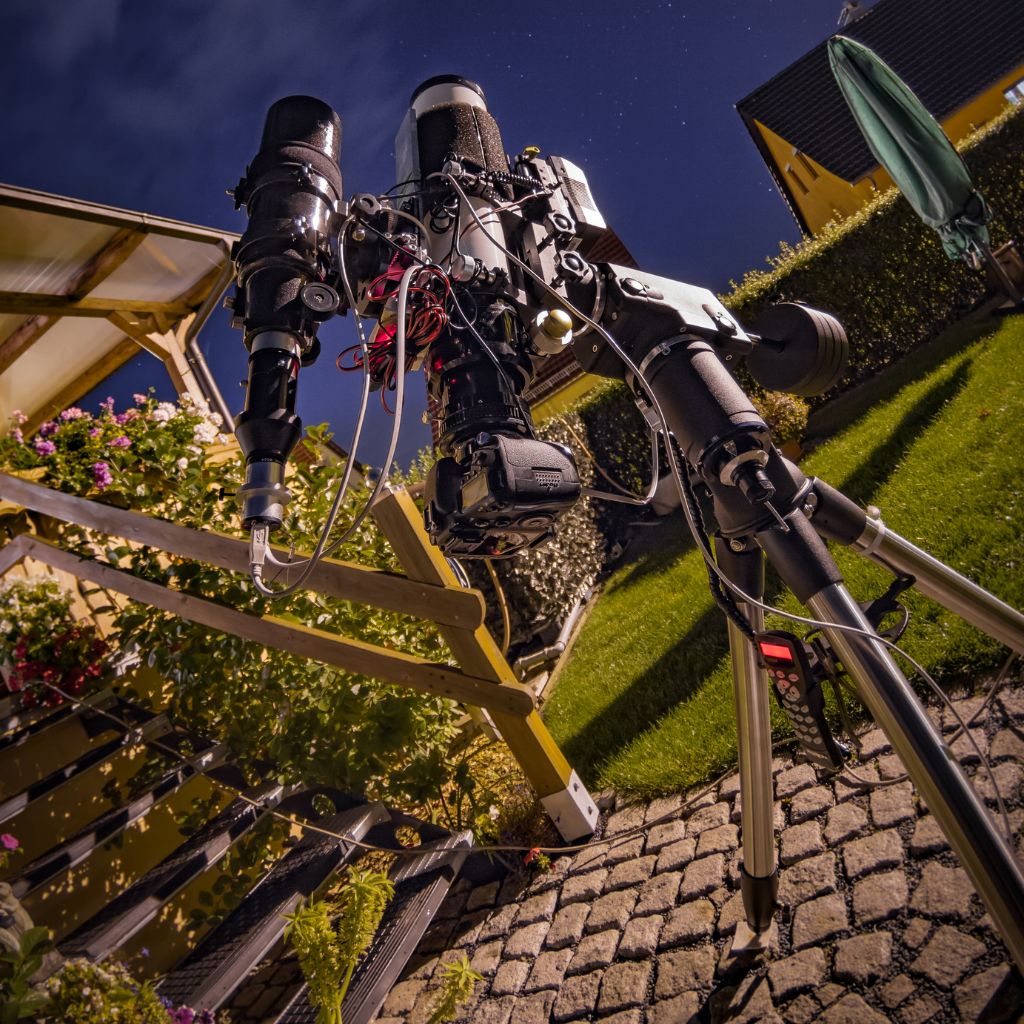This site contains affiliate links to products. I may receive a commission for purchases made through these links.
If you’re like me, there’s nothing more thrilling than gazing at the stars from your own backyard. But to get the best view, it’s not just about having a high-powered telescope. The site selection and design of your home observatory play a crucial role too.
Choosing the right location can make or break your stargazing experience. Factors such as light pollution, climate, and even local wildlife can greatly impact your observations. And let’s not forget about the design. A well-designed observatory not only enhances your viewing but also protects your equipment.
So whether you’re a seasoned astronomer or a newbie stargazer, I’m here to guide you through the ins and outs of site selection and design for home observatories. Let’s make your stargazing dreams a reality.
Importance of Site Selection for a Home Observatory
An optimal site is the cornerstone of a successful home observatory. Choosing the right site can make or break your stargazing endeavors. Factors like light pollution, atmospheric turbulence, and local wildlife activities aren’t to be overlooked.
Let’s dive into why these factors matter. Light pollution is the prime enemy of stargazing. I can’t stress enough how essential it is to contemplate this while selecting your observatory’s site. Excessive man-made light can wash out faint stars and celestial objects. Where you live could determine the amount of light pollution. For city dwellers, it’s often a greater challenge to find a darker spot. People living in rural or suburban areas generally have the upper hand. Yet, even they need to be critical about their site choice.
A common misconception is that stargazing is about finding a location with a clear, open, dark sky. There’s more to the picture. Your location’s atmospheric turbulence, termed ‘seeing’, is equally important. Poor seeing could leave your view of the cosmos blurry, even under a clear sky. When hot and cold air mix, they cause waves in our atmosphere. This wave interference blurs the detail we can see, even through a high-quality telescope. It’s mainly why astronomers prefer mountaintops. The air higher up is generally steadier and has less turbulent activity than near ground level.
Lastly, you need to be mindful of local wildlife. If your site’s near habitat for creatures like bats and birds, they might interrupt your stargazing sessions. Bats often flock to tasty bugs attracted to outdoor lighting. Don’t let these unwanted guests crash your space party!
I hope this has underscored that location is integral to a rewarding stargazing experience. Let’s move on to the observatory’s design. Following the right guidelines can further enhance your celestial viewing.
Factors to Consider for Site Selection
Observatory site selection isn’t a task to be taken lightly. It’s an important decision that has a significant impact on the quality of celestial observations obtained. Below, I’ll delve into the critical factors that should be taken into account when making this choice.
Light Pollution: It’s the arch-enemy of astronomers everywhere. Large urban areas generate a significant amount of artificial light which can interfere with the visibility of faint stars and other heavenly bodies. Therefore, selecting a location that’s far from the city lights helps improve the clarity of what you’ll be able to see.
Atmospheric Turbulence: Also known as “seeing”, atmospheric turbulence can make your view of the cosmos blurry. If the air at your location is unstable, the images you’ll get will be distorted too. Areas with less turbulent airspace are generally preferable for setting up an observatory.
Wildlife Activities: This might seem odd but trust me, it’s a crucial factor. Wildlife presence – particularly of bats and birds – around the observatory can interfere with stargazing sessions. It’s best to select a location where such disruptions would be minimal.
In addition to these factors, you’d also have to consider the convenience and safety of the location. Is it easily accessible? Are there any known hazards in the area, like heavy snowfall or landslide-prone zones?
Each site has its pros and cons. Weighing them against each other and your specific needs will help point you towards the best best location for your home observatory.
Assessing Light Pollution in Your Area
Light pollution is among the top concerns when it comes to identifying the perfect spot for the home observatory. You’ve to understand how light pollution affects your designated area and ways to evaluate it.
One efficient way to assess light pollution is by using the Bortle Dark-Sky Scale. The Bortle scale is a nine-level numeric scale that astronomers use to measure the night sky’s brightness at a particular location. A lower figure on the scale represents nearly perfect dark sky conditions, while higher values signify significant light pollution.
| Bortle Scale | Description | Effect on Observations |
|---|---|---|
| 1 – 2 | Dark skies | Ideal for observations |
| 3 – 6 | Suburban to urban skies | Moderate to serious light pollution |
| 7 – 9 | City center to inner-city sky | Severe light pollution, stargazing may be impossible |
In most urban and suburban areas, the Bortle scale is roughly between 5 and 8: representing moderate to severe light pollution. In my experience, it’s a bit difficult to find spots within the city that would fall below 3 on the Bortle Scale. But, if you live on the outskirts of the city or in rural areas, you may already have a location suitable for starting that stargazing journey.
Additionally, certain websites and apps can provide an approximate value on the Bortle scale for your area using light pollution maps. These tools are quite handy for those who wish to identify the most optimal location for their home observatories. By simply keying in your proposed location, you’d get an estimated value: giving you a clue about what to expect once you install that home observatory.
Remember, a clear, dark sky free of excessive artificial light will always improve your experience of stargazing. Hence, taking time to assess and tackle light pollution can go a long way in setting up the perfect home observatory.
Evaluating Climate and Weather Conditions
Another crucial factor to consider in selecting a home observatory site is the climate and the local weather conditions. They play a significant role in the usability of an observatory. After all, observing the night sky is significantly impacted by weather phenomena such as humidity, rainfall, cloud cover and wind.
Let’s dive into these factors one by one:
Humidity and Rainfall: In regions with high humidity, dew can form on your equipment. This not only obstructs viewing but can also damage equipment over time. Additionally, areas with frequent rainfalls have fewer clear nights for observation.
Cloud Cover: The number of clear nights a location has is crucial for stargazing. Locations with lower average cloud cover will offer more opportunities to use your observatory. It’s essential to check the year-round cloud cover data for your area.
Wind: Last but not least, wind can also interfere with astronomical observations by causing vibrations in your equipment or making it difficult to control your telescope precisely.
To investigate these factors, you could check weather websites or apps for historical weather data in your region. One such tool is the NOAA’s Climate Data Online (CDO) that provides free access to NRCS SNOTEL data and various climatological datasets.
In addition, some websites offer “astro-climatology” data, showing historical clear sky charts for potential observatory sites. These can be particularly helpful in determining the number of usable nights at a particular location.
Here’s a quick table summarizing the points:
| Factor | Why it Matters |
|---|---|
| Humidity & Rainfall | High levels can obstruct view and damage equipment |
| Cloud Cover | More clear nights increase usability |
| Wind | Wind can interfere with observations by causing vibrations |
Selecting the perfect site for a home observatory indeed takes careful planning and research. But even with light pollution, climate, and weather conditions meticulously checked and accounted for, there’s still the actual design of the observatory building to consider. But that’s a topic for another section.
Dealing with Local Wildlife and Environmental Factors
There’s more to selecting a site for your home observatory than just weather and climate conditions. You also need to weigh environmental factors and potential wildlife interference. You may find the perfect spot with crystal-clear skies, but if it’s too close or in the path of wildlife, your stargazing experience could get disrupted.
Going Green with Your Observatory
Ecological responsibility is a serious consideration in today’s age. So, when building your observatory, take into account the local ecosystem and your footprint. Select a site that’ll have minimal impact on the natural habitat.
Here are some points to ponder:
- Choose a location that’s not in the heart of wildlife activity
- Consider the effects of light pollution on nocturnal animals
- Aim for eco-friendly building materials
- Make sure you’re not disrupting local plant life or waterways with construction
Dealing with Wildlife Interference
Dealing with potential wildlife interference can be challenging, even overwhelming. Let’s face it, creatures like birds, squirrels, or raccoons can wreak havoc on your carefully planned out site. They may damage your equipment or create messes that require constant cleaning.
Here’s what you can do:
- Regularly check for nests and signs of animal activity around your observatory
- Install wildlife deterrents if necessary
- Ensure your observatory is secure when not in use
To help you identify areas with substantial wildlife activity, consider using tools such as eBird and iNaturalist. These platforms can provide invaluable information about local bird and animal populations.
Remember, coexisting with nature is essential. You’re building your observatory to admire the universe, after all – a quest that kindles our respect for all living things. Let’s ensure the journey to the stars doesn’t disrupt the rhythm of life on Earth.
Now let’s explore another vital factor in selecting your observatory site: Access and Security. The easier it is to reach, and the safer it is to use, the more you’ll get out of your astronomical adventures. Don’t forget – the journey should be as enjoyable as the destination. You’re heading to the stars, after all.
Optimizing the Design of Your Home Observatory
So you’ve accounted for environmental factors, wildlife interference, access, and security in your site selection. What’s next? It’s time to dig into the nitty-gritty, the design of your home observatory. Your design will directly impact your observing experience, so it’s crucial to get it right. Think of it as a tailor-made suit; it needs to fit your needs and requirements perfectly.
Let’s discuss a few critical points.
The dominant aspect to consider is the scope of your observatory. What do you want to observe? Stars, planets, galaxies? Your choice will influence the design options. For example, if deep sky objects are your primary prey, you’ll require a completely enclosed dome. But for general stargazing, a simple roll-off-roof design might be sufficient.
Wind and weather patterns also play a role. Consider local weather conditions along with geographical features that may affect your stargazing. The aim here is to prevent unnecessary exposure to harsh weather conditions.
Next up is the equipment room. If you’re like me, who loves his gear, you’ll want a dedicated and well-organized space for all your astronomical equipment. This allows for easy access and keeps your equipment safe.
Then there’s the layout. Your observatory should have a spacious and accessible setup. Keep cable clutter to a minimum and try to have a convenient reach to all your equipment. This not only ensures a comfortable work environment but also promotes safety.
One unique feature you might consider is automation. Features like remote-control roofs and wifi-enabled telescope mounts can enhance your astronomy experience immensely.
Keep these factors in mind when you’re designing your home observatory and you’ll be off to a promising start. It’s through this careful consideration that your observatory will meet your specific needs and align with your astronomical aspirations.
Choosing the Right Shape and Size
Crafting the ideal shape and size of your home observatory is a critical next step in your astronomical journey. It’s not merely about packing in all the equipment –it’s about creating enough space to work comfortably.
Your observatory’s architecture ought to reflect its key functions. For instance, if you’re focused on astrophotography, you’ll need space for your computer equipment nearby. Should visual observation be your prime interest, ensure there’s ample space for seating and a practical area for note-taking.
When plotting out the size of your observatory, you mustn’t ignore any space requirements for additional gear like telescopes, mounts, and other necessary astronomical devices. As important as the size and shape, is the potential for future expansion. When folks opt for a smaller setup at the beginning, they frequently regret not allowing more room for upgrades later on.
Regarding the shape of your home observatory, the two main types to consider are dome and roll-off roof designs. The choice between these fundamentally boils down to your specific requirements, budget, and astronomical goals.
The dome design is perhaps the most classic shape synonymous with observatories. It provides a protected environment, optimized for stability and minimizing stray light. Yet, it often comes at a more significant cost and could be a more technical challenging build.
In contrast, the roll-off roof design offers a broad sky view and is relatively simple to construct and operate. However, it lacks the weather and light protection offered by the dome setup.
Despite these generalized pros and cons, the perfect observatory design should be custom-built to serve your unique requirements best. Recognizing these individual needs is key to creating a productive and enjoyable astronomical experience. It’s an exciting process requiring plenty of thought but surely an adventure that’s rewarding.
Selecting the Appropriate Materials and Construction Methods
After discussing the importance of site selection and design for a home observatory, let’s delve into the crucial matter of selecting the right building materials and construction methods.
When it comes to materials, you must think about durability and maintenance. The top choice for many hobby astronomers is a treated wooden frame for its longevity and ease of repair. Others prefer steel or aluminum frames for their resilience and rust resistance. It’s a topic of debate; however, selecting the material that best fits your unique circumstances is critical.
Let’s lay down some factors to consider:
- Weather resistance: Your observatory needs to stand through all weather patterns in your region. Choose materials that can weather storms, resist rust, and endure sunlight exposure. Use materials like treated lumber or metal frames treated with rust inhibitors.
- Insulation: Depending on your location, insulation might be an important factor to consider. Insulation helps maintain temperature inside your observatory, which can be crucial for delicate equipment.
- Light pollution: Light seepage can negatively affect your observations. Choose building materials that can provide the right level of darkness within your observatory.
Proper construction methods are equally important. It’s not just about building an observatory; it’s about building one that stands the test of time. Engage a well-trained contractor experienced in observatory construction who knows how to implement the design and materials effectively.
In the domain of construction, don’t forget about adequate ventilation and wiring. Proper ventilation is necessary to prevent condensation that might damage sensitive astronomical equipment. Wiring is crucial for powering your equipment, lights, and, of course, your heaters or air conditioners, if needed.
And, remember, expansion is always a possibility. Future-proof your home observatory by planning for additional space from the outset.
Choosing the right materials and construction methods might seem daunting, but ticking these important boxes can set the foundation for a home observatory that will serve you well in the years to come. Let’s continue the journey of creating the perfect home observatory in the next section, where we’ll talk about fitting out the interior.
Incorporating Essential Features for Functionality and Convenience
While taking care of the construction basics, it’s critical not to overlook the importance of functionality and convenience. After all, we’re not just placing walls and roofs; we’re creating a haven for astronomers to explore the universe.
Convenient Access and Comfort always needs to be in the equation. Consider pathways to access the observatory that are smooth and obstruction-free to carry equipment with ease. Also, think about room for chairs and desks within the observatory, and not forgetting heating, cooling and humidity control systems.
Think beyond the present and plan for Future Expansion. The design should be adaptable to future changes and enhancements. It’ll become instrumental when you plan on adding more advanced equipment, space for storage, or even an additional observation area.
I cannot stress the importance of Intelligent Lighting enough when building an observatory. The use of red lights inside the observatory is preferred by many astronomers as it helps preserve night vision. Also, consider an exterior lighting plan that effectively minimizes light pollution, without compromising on safety and security.
Planning for Power is another crucial aspect. Wireless options can offer a solution to issues related to cord management. However, these might not be enough to feed power-hungry telescopes and computers. Hence, a detailed power plan with ample and well-distributed outlets is mandatory.
Incorporating these considerations into your home observatory design isn’t just about creating an aesthetically pleasing structure. Instead, it’s about crafting a space that functions seamlessly as an extension of your passion and curiosity for the cosmos. Evaluating every aspect critically, and planning meticulously will lead you to not just build an observatory, but a sanctuary for stargazers.
Protecting Your Equipment from the Elements
As crucial as choosing the best location and designing for functionality, it’s equally important to protect your observational equipment from the elements. Unpredictable weather, fluctuations in temperature, and harmful UV rays can all have detrimental effects on your precious stargazing apparatus.
In retrospect, often overlooked is the importance of insulation in a home observatory. Insulation helps maintain a constant internal temperature and minimizes the risk of condensation, a silent killer for delicate optics. Therefore, consider insulating your walls, roof, and even the floor. The choice of insulation material is significant here. From foam boards to spray foams or even blanket insulation, choose what best suits your climatic conditions and budget.
The next factor is creating a waterproof environment inside the observatory. To protect against rain or snow entering your observatory, your observatory needs a watertight roof and walls, a filtered ventilation system, and water-resistant entrance doors. Don’t forget that quality weatherstripping and waterproof sealant around doors and windows will further enhance this protection.
UV protection is equally vital. The same sunlight that makes daytime observations impossible can also damage your equipment over time. Using UV blocking materials or paints during construction will shield your equipment from the sun’s harmful rays.
Oh, and let’s not neglect the wind factor. How will your observatory react in strong wind? Will it sway or shake? Do consider these elements in your design. Strong, robust, and wind-resistant construction materials should be prioritized to ensure your observatory can withstand the test of high winds.
Lastly, don’t dismiss the humble dust and dirt. These seemingly insignificant particles can scratch delicate optical surfaces and infiltrate sensitive mechanical parts. A clean, dust-free environment is essential for things to work smoothly. Installing dust filters on ventilation openings and keeping up with regular cleaning will no doubt pay off in the long run.
After all, an observatory is more than just a shelter. It’s a sentinel, bearing the brunt of the elements to safeguard your precious window to the cosmos. Consequently, designing with protection from the elements in mind can unquestionably extend the longevity and effectiveness of your observation equipment.
Conclusion
Choosing the right site for your home observatory isn’t just about finding the perfect view. It’s about considering environmental factors, wildlife interference, accessibility, and security. Your choice of materials and construction methods can make or break your observatory’s durability, weather resistance, and light pollution control.
Don’t forget the importance of protecting your observational equipment from the elements. Insulation, waterproofing, UV protection, wind resistance, and dust prevention can all extend the longevity and effectiveness of your equipment. When it comes to site selection and design for home observatories, it’s all about balance. It’s not an easy task, but with careful planning and consideration, you can create a home observatory that stands the test of time.








